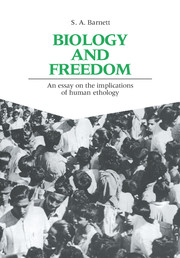Book contents
- Frontmatter
- Contents
- List of illustrations
- Preface
- Acknowledgements
- Part 1 An introduction
- Part 2 Homopugnax: the violent species
- Part 3 Homo egoisticus: the selfish species
- 6 Evolution and natural selection
- 7 Environment and heredity
- 8 Stories of human evolution
- 9 Darwinism, genetics and politics
- Part 4 Homo operans: the greedy species
- Part 5 Homo sapiens: the human species
- Glossary
- Notes
- References
- Name index
- Subject index
8 - Stories of human evolution
Published online by Cambridge University Press: 04 August 2010
- Frontmatter
- Contents
- List of illustrations
- Preface
- Acknowledgements
- Part 1 An introduction
- Part 2 Homopugnax: the violent species
- Part 3 Homo egoisticus: the selfish species
- 6 Evolution and natural selection
- 7 Environment and heredity
- 8 Stories of human evolution
- 9 Darwinism, genetics and politics
- Part 4 Homo operans: the greedy species
- Part 5 Homo sapiens: the human species
- Glossary
- Notes
- References
- Name index
- Subject index
Summary
Yea, ye would cast lots upon the fatherless,
And make merchandise of your friend.
Job: 6:27.The picture of our species, framed in evolutionary biology, that emphasizes aggressiveness (especially among men), egoism, conflict between the sexes, nepotism and deceit, is – we are told – designed to demystify human conduct. But when we try to assess this portrait we find that it conceals nearly everything important about us.
Comparisons
We begin with humanity before agriculture. Rudyard Kipling, with questionable poetic licence, tells how
In the Neolithic Age, savage warfare did I wage,
For food and fame and woolly horses' pelt.
The cartoon figure of the club-wielding cave dweller, with women and children only in the background, is one form of Homo egoisticus, and it reflects not facts but the outlook of male anthropologists and other writers. Statements on the ancestral roles of the sexes, and on ancient social organizations, are still surmise; but the importance of women as food gatherers in pre-agricultural groups has been recorded in detail: the idea of women as stay-at-homes has been given up; even in late pregnancy a woman can cope with heavy burdens and often does so. To what extent women have, in the past, been hunters is unknown; but in some modern groups women hunt or hunted regularly. In the north of Australia Tiwi women caught bandicoots, possums and a variety of reptiles, including iguanas.
- Type
- Chapter
- Information
- Biology and FreedomAn Essay on the Implications of Human Ethology, pp. 116 - 140Publisher: Cambridge University PressPrint publication year: 1989



